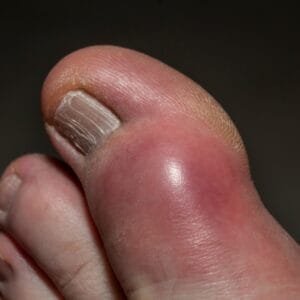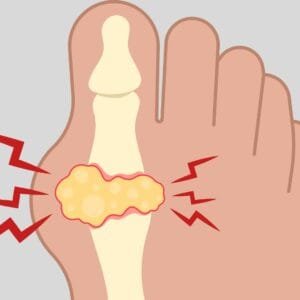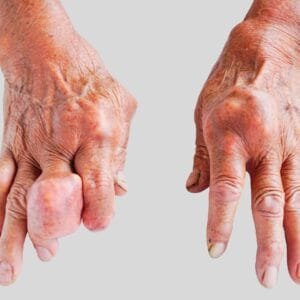Gout: Causes, Symptoms, and Treatment
Gout is a common and complex form of arthritis characterized by sudden, severe pain, redness, and swelling in the joints. It is caused by the accumulation of uric acid crystals in the joints, leading to inflammation and intense discomfort. Gout most often affects the joint at the base of the big toe but can occur in other joints such as the knees, elbows, wrists, and fingers. Proper diagnosis and treatment can help manage symptoms and prevent future flare-ups.



What is Gout?
Gout is a form of inflammatory arthritis that occurs when high levels of uric acid in the blood (a condition called hyperuricemia) lead to the formation of urate crystals in the joints. These sharp, needle-like crystals cause sudden and severe pain, commonly referred to as a gout attack.
Gout typically progresses through four stages:
- Asymptomatic Hyperuricemia: Elevated uric acid levels without symptoms.
- Acute Gout: Sudden attacks of joint pain and inflammation.
- Intercritical Gout: Periods between attacks with no symptoms.
- Chronic Tophaceous Gout: Persistent joint pain and the development of hard deposits of uric acid (tophi).
Causes of Gout
The primary cause of gout is the buildup of uric acid in the blood, which can occur due to:
1. Dietary Factors
- Excessive consumption of purine-rich foods, such as:
- Red meat.
- Shellfish.
- Alcohol (especially beer).
- Sugary beverages.
2. Decreased Uric Acid Excretion
- Conditions that impair kidney function, such as chronic kidney disease, can reduce the ability to excrete uric acid.
3. Medical Conditions
- High blood pressure, diabetes, metabolic syndrome, and obesity increase gout risk.
4. Genetics
- A family history of gout may increase the likelihood of developing the condition.
5. Medications
- Certain drugs, such as diuretics, low-dose aspirin, and immunosuppressants, can raise uric acid levels.
Symptoms of Gout
Gout symptoms often come on suddenly, usually at night, and may include:
Common Symptoms
- Severe Joint Pain:
- Intense pain, often in the big toe (podagra).
- Swelling and Redness:
- The affected joint becomes swollen, tender, and warm to the touch.
- Limited Range of Motion:
- Difficulty moving the joint due to pain and stiffness.
- Fever:
- In severe cases, inflammation may cause mild fever.
Chronic Symptoms
- Tophi:
- Hard lumps of uric acid crystals under the skin, typically around joints.
- Joint Deformity:
- Prolonged untreated gout can damage joints, leading to deformities.
Risk Factors for Gout
Several factors increase the risk of developing gout:
- Age and Gender:
- Gout is more common in men and postmenopausal women.
- Obesity:
- Excess weight contributes to higher uric acid production.
- Diet:
- High intake of purine-rich foods and alcohol.
- Medical History:
- Conditions such as hypertension, kidney disease, or a previous gout attack.
- Medications:
- Use of diuretics or aspirin.
Diagnosis of Gout
Gout diagnosis involves a combination of medical history, physical examination, and diagnostic tests:
- Physical Examination:
- Identifying swollen, red, and tender joints.
- Joint Fluid Analysis:
- Extracting and examining joint fluid under a microscope to detect urate crystals.
- Blood Tests:
- Checking uric acid levels (although high levels do not always confirm gout).
- Imaging Tests:
- X-rays: Identify joint damage from chronic gout.
- Ultrasound: Detect urate crystals in joints or tophi.
Treatment Options for Gout
Effective treatment aims to reduce pain during acute attacks and lower uric acid levels to prevent future flare-ups.
Medications for Acute Attacks
- Nonsteroidal Anti-Inflammatory Drugs (NSAIDs):
- Over-the-counter or prescription NSAIDs (e.g., ibuprofen, naproxen) relieve pain and inflammation.
- Colchicine:
- Reduces inflammation during acute gout attacks.
- Corticosteroids:
- Prednisone or other corticosteroids may be used if NSAIDs are ineffective.
Long-Term Medications
- Uric Acid-Lowering Drugs:
- Allopurinol and febuxostat reduce uric acid production.
- Uricosurics:
- Probenecid helps the kidneys excrete uric acid more effectively.
Lifestyle and Home Remedies for Gout
Lifestyle changes play a critical role in managing and preventing gout attacks:
Dietary Adjustments
- Avoid High-Purine Foods:
- Limit intake of red meat, organ meats, shellfish, and sugary drinks.
- Increase Water Intake:
- Stay hydrated to help flush out uric acid.
- Eat Anti-Inflammatory Foods:
- Incorporate cherries, berries, and foods rich in vitamin C.
Exercise and Weight Management
- Regular Physical Activity:
- Maintain a healthy weight to reduce uric acid levels.
- Avoid Crash Diets:
- Rapid weight loss can raise uric acid levels.
Preventing Gout
Preventive strategies focus on maintaining healthy uric acid levels:
- Stay Hydrated:
- Drink plenty of water to dilute uric acid and promote excretion.
- Limit Alcohol:
- Reduce alcohol consumption, particularly beer.
- Monitor Medications:
- Consult your doctor about medications that may elevate uric acid levels.
- Regular Checkups:
- Monitor uric acid levels and overall health with routine medical exams.
Complications of Gout
Untreated gout can lead to serious complications, including:
- Chronic Gout:
- Frequent and severe attacks causing persistent joint pain and damage.
- Kidney Stones:
- Uric acid crystals can form stones in the urinary tract.
- Joint Damage:
- Prolonged inflammation may permanently damage joints.
- Tophi Formation:
- Hard deposits of uric acid that can become inflamed and painful.
FAQs about Gout
1. What causes gout?
Gout is caused by high levels of uric acid in the blood, which form crystals in the joints and cause inflammation.
2. What are the symptoms of a gout attack?
Symptoms include sudden, severe joint pain, swelling, redness, and warmth, often affecting the big toe.
3. Can gout be cured?
While there is no cure, gout can be effectively managed with medications, lifestyle changes, and a healthy diet.
4. What foods should be avoided with gout?
Avoid purine-rich foods like red meat, organ meats, shellfish, alcohol, and sugary drinks.
5. How is gout treated?
Treatment includes anti-inflammatory medications for acute attacks and uric acid-lowering drugs for long-term management.
Conclusion
Gout is a manageable condition with the right combination of medications, lifestyle changes, and dietary adjustments. Early diagnosis and treatment are key to reducing the frequency and severity of gout attacks and preventing complications. If you suspect you have gout or experience recurring joint pain, consult a healthcare provider for a tailored treatment plan.
